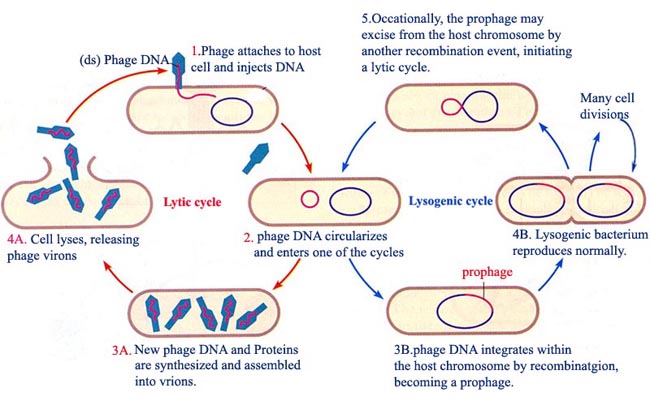第一章 病毒学基础
一.增殖的定义
二.增殖的机制
三.增殖的过程
四.溶原性循环

|
第一章 病毒学基础 |
||
|
|
||
|
第四节.病毒的增殖
Viral Multiplication
|
||
| 病毒的种类很多,它们的繁殖方式既有共性又有各自的特点,这里以噬菌体为重点,从以下方面来介绍病毒的增殖: | ||
|
|
||
|
一.增殖的定义 二.增殖的机制 三.增殖的过程 四.溶原性循环 |
 |
|
| 一.增殖的定义 (Definition of
multiplication)
|
||
| 病毒感染宿主细胞后,利用宿主进行病毒核酸的复制和蛋白质的合成,最后装配成子代病毒,并由宿主细胞释放出来。这个过程称为病毒的增殖。
The nucleic acid in a virion contains only a few of the genes needed for the synthesis of new viruses. The enzymes used in the viral life cycle are synthesized and functional only when the virus is within the host cell. Thus, for a virus to multiply, it must invade a host cell and take over the host's metabolic machinery (such as enzymes needed for protein synthesis, ribosomes, tRNA, and energy etc.).
|
||
|
|
|
二. 增殖的机制 Mechanisms of
Viral Multiplication
Because the T-even
bacteriophages (T2, T4, and T6) have been studied most extensively the multiplication of T-even bacteriophages
in their host, E.coli, will be described as an example of the lytic
cycle. |
|
mechanism [5mekEnizEm]n.机械装置, 机构, 机制 lytic [5litik] adj. 溶胞作用的 lysogenic [9laIsEJ`dVenIk]adj.[生]生成细胞溶素的,生成溶胞素的,溶原的,产噬的 lysis [5laisis] n 细胞[菌]溶解 extensively adv.广阔地 temperat[5tempErit]adj.有节制的, 适度的, 戒酒的, (气候)温和的
temperate
bacteriophage:温和噬菌体 |
|||||
 |
|||||
|